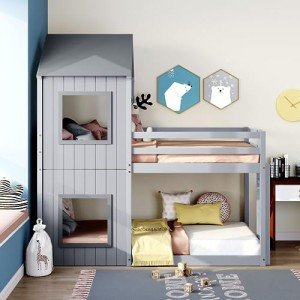The Ultimate Guide to Kids Bunk Beds: Maximizing Space and Fun
With the rise of vertical living and smaller areas, the appeal of bunk beds has actually skyrocketed among families. This Web site offer a useful sleeping option, specifically in shared rooms, but they likewise bring an element of fun into a kid's life. This extensive guide digs into the functions, benefits, and considerations of kids' bunk beds, making it much easier for parents to select the ideal bed for their youngsters.
Functions of Kids Bunk Beds
Bunk beds are versatile furniture pieces that serve more than a single function. Here are some key features to consider:
| Feature | Description |
|---|---|
| Product | Bunk beds can be constructed from wood, metal, or a combination of both, using varying levels of sturdiness and style alternatives. |
| Safety Features | Many bunk beds come geared up with guardrails, safe and secure ladders, and topped assistances for security, specifically important for children. |
| Design Variety | Choices range from traditional styles to modern designs, ensuring a match for any room décor. |
| Space-Efficiency | Bunk beds utilize vertical space, making them perfect for smaller sized rooms. |
| Convertible Options | Some models can be transformed into 2 different beds, providing versatility as kids grow. |
| Storage Solutions | Some bunk beds include integrated storage drawers or racks, helping to keep the space organized. |
Advantages of Kids Bunk Beds
Investing in a bunk bed includes several benefits:
- Space Saving: Bunk beds optimize flooring space, permitting more play area or storage solutions.
- Enjoyable Factor: With a bunk bed, kids belong that fosters creativity and friendship during slumber parties or playdates.
- Economical: Instead of buying two different beds, a bunk bed can accommodate 2 kids simultaneously, saving cash in the long run.
- Versatility: Many bunk beds can be disassembled or converted into twin beds, making them a long-term investment as kids's needs change.
- Social Interaction: Bunk beds encourage family bonding and relationships, supplying an inviting space for children to share stories and laughter.
Factors to consider When Choosing a Kids Bunk Bed
When choosing the best bunk bed for a kid, parents should take into consideration different aspects:
- Safety Standards: Ensure that the bunk bed adhere to security policies and includes essential security features.
- Age Appropriateness: Different models accommodate different age. For example, traditional bunk beds may not appropriate for younger children.
- Room Dimensions: Measure the bed room to ensure the bunk bed fits appropriately, permitting for space to walk around conveniently.
- Weight Capacity: Consider the weight load of each bed and guarantee it accommodates the child's weight comfortably.
- Design Preferences: Letting children take part in the selection process can assist them feel more ecstatic about their new bed.
Types of Kids Bunk Beds
Bunk beds are available in various styles and setups to suit different needs:
| Type | Description |
|---|---|
| Standard Bunk Bed | A timeless design with one bed stacked on top of another, usually using a ladder to access the top bunk. |
| L-Shaped Bunk Bed | Functions two bunk beds connected in an L-shape, frequently more spacious and suitable for kids sharing a space but requiring a bit more space. |
| Triple Bunk Bed | Makes up three stacked beds, perfect for taking full advantage of sleeping arrangements in extremely limited spaces. |
| Loft Bed | A raised bed with space underneath that can function as a backyard, study corner, or extra storage. |
| Futon Bunk Bed | Integrates a bunk bed on the top with a futon or couch underneath, making it great for sleepovers and maximizing room usage. |
| Convertible Bunk Bed | Can be separated into two specific beds, providing versatility as children's needs change. |
Taking Care Of Kids Bunk Beds
Keeping bunk beds is crucial for making sure durability and safety. Here are some simple care practices:
- Regular Inspections: Check the bed frequently for loose screws and tightened bolts to ensure stability.
- Cleanliness: Keep bed linen tidy and fresh, rotating bed mattress for even wear.
- Guardrails: Ensure guardrails are secure and in location, specifically if kids tend to walk around a lot in their sleep.
- Air Circulation: Ensure the bed has adequate airflow, preventing moisture accumulation that can lead to mold or mildew.
FAQs About Kids Bunk Beds
Q1: At what age can a child securely use a bunk bed?
A1: Generally, children aged 6 and older are thought about safe to use the upper bunk due to the height and stability aspects included.
Q2: Can I place a bunk bed near a window?
A2: It is advisable to prevent putting a bunk bed near windows to minimize the danger of falling or injuries.
Q3: Are bunk beds safe for more youthful children?
A3: While some modern bunk beds come with safety features accommodating more youthful kids, it is typically recommended to wait till they are older, normally over 6 years.
Q4: What is the normal weight limitation for top bunks?
A4: Weight limitations vary by design however usually range from 150 to 250 pounds. Constantly refer to the manufacturer's requirements.
Q5: How frequently should I examine the bunk bed's safety functions?
A5: It is a good idea to perform a security check every few months or whenever you notice any signs of wear.
Kids' bunk beds act as a strategic option for households wanting to make the most of space while providing a fun and interesting sleeping environment for their children. With a range of options available-- from basic designs to loft beds-- parents have the flexibility to select something that fulfills their family's particular requirements. By considering essential aspects such as safety, room suitability, and their kids's choices, parents can make an educated option, making sure that each child is excited about bedtime while taking advantage of a well-organized space.

